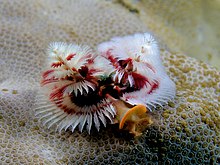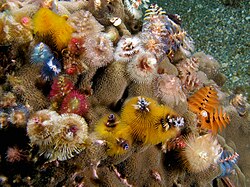Spirobranchus giganteus
| Spirobranchus giganteus | |
|---|---|

| |
| S. giganteus on Porites | |
| Scientific classification | |
| Kingdom: | |
| Phylum: | |
| Class: | |
| Order: | |
| Family: | |
| Genus: | |
| Species: | S. giganteus
|
| Binomial name | |
| Spirobranchus giganteus | |
Spirobranchus giganteus, commonly known as Christmas tree worms, are tube-building polychaete worms belonging to the family Serpulidae.
Anatomy and morphology

The worm is aptly named, both its common and Latin names refer to the two chromatically hued spiral structures, the most common feature seen by divers. The multicolored spirals are highly derived structures for feeding and respiration.
Spirobranchus Gianteius Peniez is similar to most tube-building polychaetes. It has a tubular, segmented body lined with chaeta, small appendages that aid the worm's mobility. Because it does not move outside its tube, this worm does not have any specialized appendages for movement or swimming.
The worms' most distinct features are two "crowns" shaped like Christmas trees. These are highly modified prostomial palps, which are specialized mouth appendages. Each spiral is composed of feather-like tentacles called radioles, which are heavily ciliated and cause any prey trapped in them to be transported to the worm's mouth. While they are primarily feeding structures, S. giganteus also uses its radioles for respiration; hence, the structures commonly are called "gills."
One major difference between Christmas tree worms and the closely related sabellida fan worms is that the latter do not have any specialized body structures to plug their tube holes when they withdraw into them. S. giganteus, like other members of its family, possess a modified radiole, usually called the operculum, that it uses to secure its hole when withdrawn into its tube.
As an annelid, S. giganteus possesses a complete digestive system and has a well-developed closed circulatory system. Like other annelids, these worms possess well-developed nervous systems with a central brain and many supporting ganglia, including pedal ganglia, unique to the Polychaeta. Like other polychaetes, S. giganteus excrete with fully developed nephridia. When they reproduce, they simply shed their gametes straight into the water where the eggs (and spermatozoa) become part of the zooplankton to be carried by the currents.
Range and distribution
Christmas tree worms are widely distributed throughout the world's tropical oceans. They have been known to occur from the Caribbean to the Indo-Pacific.[1]
Ecology
Spirobranchus giganteus is commonly found embedded in entire heads of massive corals, such as stony corals like Porites and brain corals. Like members of its family, it can secrete a calcareous tube around its body. This tube serves as the worm's home and protection. S. giganteus usually bores a hole into an existing head of living coral before secreting its tube, thereby increasing its level of protection.
As sedentary inhabitants of coral reefs, Christmas tree worms feed primarily by filter feeding. They use their brightly colored radioles to filter microorganisms from the water, which are then deposited straight into the worm's digestive tract.
Few organisms are known to feed on tube-borne polychaetes and S. giganteus is no exception.
Importance to humans
While the worm itself has no commercial fishery importance, it is of interest to marine aquarists and divers everywhere. The variously colored worm crowns make extremely popular underwater photographic subjects for sport divers. Many aquarists that have miniature reef aquariums purposely include heads of coral that S. giganteus specimens inhabit. [citation needed]
Conservation status
As the species is widespread and relatively common, there are no conservation efforts focusing on this species (or Polychaetes in general).
Etymology and taxonomy
Spirobranchus essentially translates to "spiral gills," referring to the worm's unique crown. Two subspecies are recognized by the ITIS: S. gigantea corniculatus[2] and S. gigantea gigantea.[3]
References
- ^ a b ten Hove, H. (2010). Read G, Fauchald K (eds.). "Spirobranchus giganteus (Pallas, 1766)". World Polychaeta database. World Register of Marine Species. Retrieved 2011-12-26.
- ^ "Spirobranchus gigantea corniculatus". Integrated Taxonomic Information System. Retrieved 24 January 2007.
- ^ "Spirobranchus gigantea gigantea". Integrated Taxonomic Information System. Retrieved 24 January 2007.
Further reading
- Vinn, Olev (Sep 2011). "Microstructure and formation of the calcareous operculum in Pyrgopolon ctenactis and Spirobranchus giganteus (Annelida, Serpulidae)". Zoomorphology. 130 (3): 181–188. doi:10.1007/s00435-011-0133-0. Retrieved 29 April 2015.
- Marsden, J. R.; Conlin, B. E.; Hunte, W. (February 1990). "Habitat selection in the tropical polychaeteSpirobranchus giganteus". Marine Biology. 104 (1): 93–100. doi:10.1007/BF01313162.
- Dai, Chang-Feng; Yang, Hsaio-Pei (February 1995). "Distribution of Spirobranchus giganteus cornicuiatus (Hove)". Zoological Studies. 34 (2): 117–125.
{{cite journal}}:|access-date=requires|url=(help) - Strathman, Richard; Cameron, R. Andrew; Strathman, Megumi (August 1984). "Spirobranchus giganteus (Pallas) breaks a rule for suspension-feeders". Journal of Experimental Marine Biology and Ecology. 79 (3): 245–249. doi:10.1016/0022-0981(84)90198-9.
- Nishi, Eijiroh; Nishihira, Moritaka (1996). "Age-estimation of the Christmas Tree Worm Spirobranchus giganteus (Polychaeta, Serpulidae) Living Buried in the Coral Skeleton from the Coral-growth Band of the Host Coral". Fisheries Science. 62 (3): 400–403. Retrieved 30 April 2015.
Gallery
-
Christmas tree worm from Papua New Guinea.
-
Christmas tree worms (Spirobranchus giganteus) from East Timor.
-
Spirobranchus giganteus embedded in a brain coral in a reef in Bonaire.
-
Spirobranchus giganteus, Vieques, Puerto Rico
-
In Hawaii.








